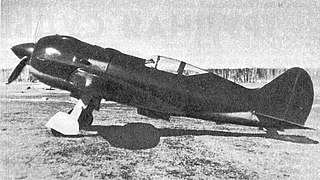
The Yakovlev UT-2 is a single-engine tandem two-seat low-wing monoplane that was the standard Soviet trainer during World War II. It was used by the Soviet Air Force from 1937 until replaced by the Yakovlev Yak-18 during the 1950s.

The Yakovlev Yak-2 was a short-range Soviet light bomber/reconnaissance aircraft used during World War II. It was produced in small numbers, and most of them were destroyed during the opening stages of Operation Barbarossa.

The Mikoyan-Gurevich DIS was a prototype Soviet heavy fighter of World War II, envisioned to serve primarily in the escort fighter role. The service designation MiG-5 was reserved for the production version of the aircraft. Competing designs in the USSR included the Grushin Gr-1, Polikarpov TIS and Tairov Ta-3.

The Yakovlev Yak-16 was a Soviet light transport that first flew in 1947. Prototypes were built in both passenger and military cargo versions, but neither was put into production as the Antonov An-2 was felt to be more versatile.

The Polikarpov I-185 was a Soviet fighter aircraft designed in 1940. It was flown with three engines but all of them were either insufficiently developed for service use or their full production was reserved for other fighters already in production. The I-185 program was cancelled on 27 January 1943. Engines used with the I-185 included the Shvetsov M-71, which was more prominent and the Shvetsov M-82, which was also used on Lavochkin La-5 fighters. Only a few M-82 variants were produced.

The Yakovlev Yak-6 was a Soviet twin-engined utility aircraft, developed and built during World War II. It was used as a short-range light night bomber and a light transport.
The Sukhoi Su-8 or DDBSh was a Soviet prototype ground-attack aircraft of World War II.

The Yakovlev EG (Eksperimentalnyi Gelikopter), also commonly known as the Yak-M11FR-1 and Sh (Shootka), was an experimental aircraft with coaxial rotors. The prototype was first flown by V.V. Tezavrovsky in December 1947.
The Yakovlev Yak-20 was an experimental piston-engined trainer developed in the Soviet Union in 1949. It did not go into production.
The Yakovlev Yak-5 was an experimental trainer aircraft designed by Yakovlev OKB in the Soviet Union, and first flown in 1944.

The Yakovlev Yak-8 was a Soviet utility aircraft developed during World War II. It was not accepted for production, but received the NATO reporting name "Crib" anyway.

The Yakovlev Yak-200 was a prototype Soviet multi-engine trainer built during the 1950s. A modified version was built as the Yak-210 for navigator training, but only one example of each was built before the program was cancelled in 1956.

The Polikarpov NB was a Soviet twin-engined bomber designed during World War II. Only a single prototype had been built before the program was terminated upon the death of Nikolai Nikolaevich Polikarpov, the head of the aircraft's design bureau, in 1944.
The Yakovlev UT-3, initially known as the AIR-17 and then Ya-17, was a twin-engine low-wing monoplane aircraft designed by Alexander Sergeyevich Yakovlev for the Soviet Air Force (VVS).
The Yakovlev AIR-6 was a Soviet light utility aircraft of the 1930s. It was a single-engined high-wing monoplane designed by Alexander Sergeyevich Yakovlev, with 128 being built.

The Yakovlev AIR-7 was a prototype Soviet high performance light aircraft of the 1930s. It was a two-seat single-engined monoplane, which demonstrated excellent performance during testing. After the prototype almost crashed as a result of flutter, its designer, Alexander Sergeyevich Yakovlev suffered temporary disgrace and no production followed.
The Yakovlev Ya-19,, was a 5-seat light transport aircraft developed directly from the Yakovlev UT-3 during the late 1930s. The Ya-19 did not enter production, despite positive results from flight trials, due to the lack of development of the UT-3 and cancellation of the Voronezh MV-6 engine program, which were the result of changing priorities in the face of the Great Patriotic War.

TheYakovlev AIR-9 / AIR-9bis was a 2-seat sport aircraft designed and built in the USSR during the early 1930s.
The Yakovlev AIR-11, also known as Yakovlev LT-1, was a 3-seat low-wing touring cabin monoplane designed by A.S. Yakovlev in the USSR, circa 1936.
The Yakovlev Ya-21,, was a single-seat high-speed sport aircraft / fighter-trainer designed and built in the Soviet Union in the late 1930s.












